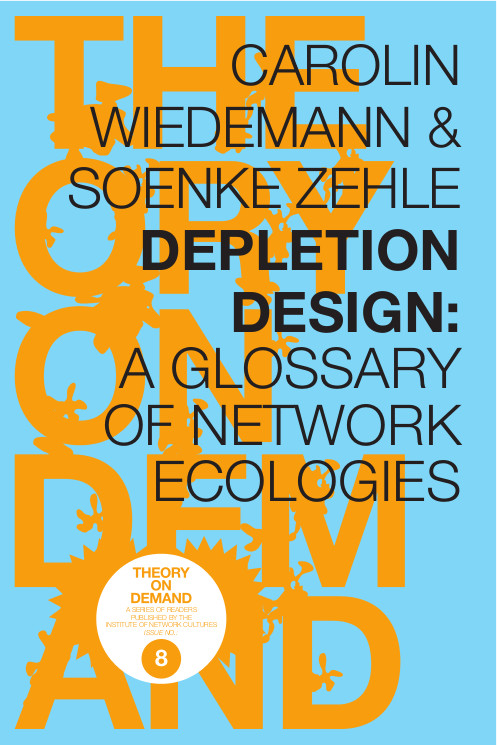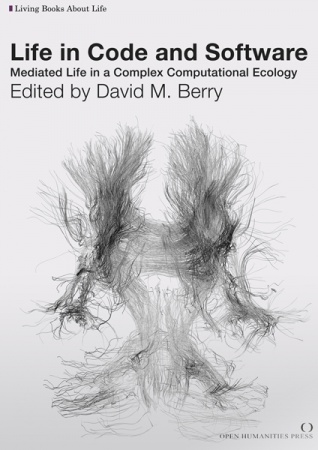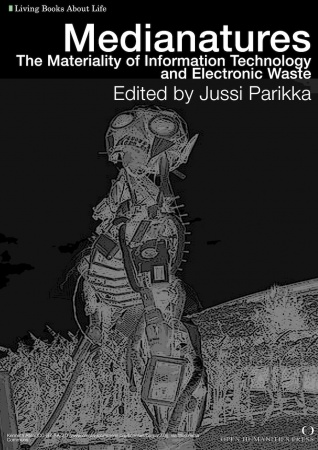Carolin Wiedemann, Soenke Zehle (eds.): Depletion Design: A Glossary of Network Ecologies (2012)
Filed under book | Tags: · algorithm, anonymous, architecture, biopolitics, commons, creative industries, cyborg, design, ecology, hackerspace, media ecology, network ecology, networks, politics, remix, software, spam, technology, theory

“Depletion Design suggests that ideas of exhaustion cut across cultural, environmentalist, and political idioms and offers ways to explore the emergence of new material assemblages. Soenke Zehle and Carolin Wiedemann discuss Depletion Design with Marie-Luise Angerer, Jennifer Gabrys and David M. Berry, inviting tm13 participants into a collaborative reflection on the necessity to understand human beings as one species among others – constituted by interactions of media, organisms, weather patterns, ecosystems, thought patterns, cities, discourses, fashions, populations, brains, markets, dance nights and bacterial exchanges (Angerer); on the material leftovers of electronics as provocations to think through and rework practices of material politics that may be less exploitative within our natural-cultural relationships (Gabrys); and on lines of flight from and through the computational – about expanding them into new ways of living beyond current limitations and towards new means of judgment and politics (Berry).
We, or so we are told, are running out of time, of time to develop alternatives to a new politics of emergency, as constant crisis has exhausted the means of a politics of representation too slow for the state of exception, too ignorant of the distribution of political agency, too focused on the governability of financial architectures. But new forms of individual and collective agency already emerge, as we learn to live, love, work within the horizon of depletion, to ask what it means to sustain ourselves, each other, again. Of these and other knowledges so created, there can no longer be an encyclopedia; a glossary, perhaps.”
Contributors: Marie-Luise Angerer (Cyborg), Franco ‘Bifo’ Berardi (Exhaustion, Soul Work), David M. Berry (On Terminality), Zach Blas (Queer Darkness), Drew S. Burk (Grey Ecology), Gabriella Coleman (Anonymous), Heidi Rae Cooley (Ecologies of Practice), Sebastian Deterding (Playful Technologies, Persuasive Design), Jennifer Gabrys (Natural History, Salvage), Johannes Grenzfurthner & Frank A. Schneider (Hackerspace), Eric Kluitenberg (Sustainable Immobility), Boyan Manchev (Disorganisation, Persistence), Lev Manovich (Software), Sonia Matos (Wicked Problems), Timothy Morton (Ecology without Nature), Jason W. Moore (Crisis), Anna Munster (Digital Embodiment), Eduardo Navas (Remix[ing] Re/Appropriations), Brett Neilson (Fracking), Sebastian Olma (Biopolitics, Creative Industries, Vitalism), Luciana Parisi (Algorithmic Architecture), Jussi Parikka (Dust Matter), Judith Revel (Common), Ned Rossiter (Dirt Research), Sean Smith (Information Bomb), Hito Steyerl (Spam of the Earth)
Publisher Institute of Network Cultures, Amsterdam, Dec 2012
Theory on Demand series, 8
Creative Commons Attribution-NonCommercial-ShareAlike 3.0 Netherlands License
ISBN 9789081857512
via jussiparikka.net
PDF, PDF (updated on 2015-7-9)
Comment (0)David M. Berry (ed.): Life in Code and Software: Mediated Life in a Complex Computational Ecology (2012)
Filed under living book | Tags: · code, computing, life, media ecology, media literacy, software

The essays in this collection, edited by David M. Berry, Senior Lecturer in Digital Media in the Department of Political and Cultural Studies at Swansea University, explore the relationship between living, code and software. For Berry, technologies of code and software increasingly make up an important part of our urban environment – indeed, their reach stretches to even quite remote areas of the world. Life in Code and Software introduces and explores the way in which code and software are becoming the conditions of possibility for human living, crucially forming a computational ecology, made up of disparate software ecologies we inhabit. As such we need to take account of this new computational environment, Berry argues, and think about how today we live in a highly mediated, code-based world – a world where computational concepts and ideas are foundational, and within which, code and software become the paradigmatic forms of knowing and doing.
Publisher Open Humanities Press, July 2012
Living Books About Life series
ISBN 9781607852834
View online (wiki/PDF/HTML articles/videos)
PDF (PDF’d Introduction with hyperlinked articles)
Jussi Parikka (ed.): Medianatures: The Materiality of Information Technology and Electronic Waste (2011-)
Filed under living book | Tags: · ecology, ecosophy, electronic waste, energetics, energy, materiality, media ecology, naturecultures, technology

“Medianatures picks up from Donna Haraway’s idea of naturecultures – the topological continuum between nature and culture, the material entwining and enfolding of various agencies, meanings and interactions. Medianatures gives the concept of naturecultures a specific emphasis, and that emphasis is at the core of this living book. It is a useful concept and framework for investigating some of the ways in which our electronic and high-tech media culture is entwined with a variety of material agencies. The notion of ‘materiality’ is taken here in a literal sense to refer, for instance, to ‘plasma reactions and ion implantation’ (Yoshida, 1994: 105) – as in processes of semiconductor fabrication, or to an alternative list of media studies objects and components which are studied from an e-waste management perspective: ‘metal, motor/compressor, cooling, plastic, insulation, glass, LCD, rubber, wiring/electrical, concrete, transformer, magnetron, textile, circuit board, fluorescent lamp, incandescent lamp, heating element, thermostat, brominated flamed retardant (BFR)-containing plastic, batteries, CFC/HCFC/HFC/HC, external electric cables, refractory ceramic fibers, radioactive substances and electrolyte capacitors (over L/D 25 mm)’, and which themselves are constituted from a range of materials – plastics, wood, plywood, copper, aluminum, silver, gold, palladium, lead, mercury, arsenic, cadmium, selenium, hexavalent chromium and flame retardants (Pinto, 2008).” (from Introduction)
Publisher Open Humanities Press
Living Books About Life series
View online (wiki/PDF/HTML articles)
PDF (PDF’d Introduction with hyperlinked articles)

